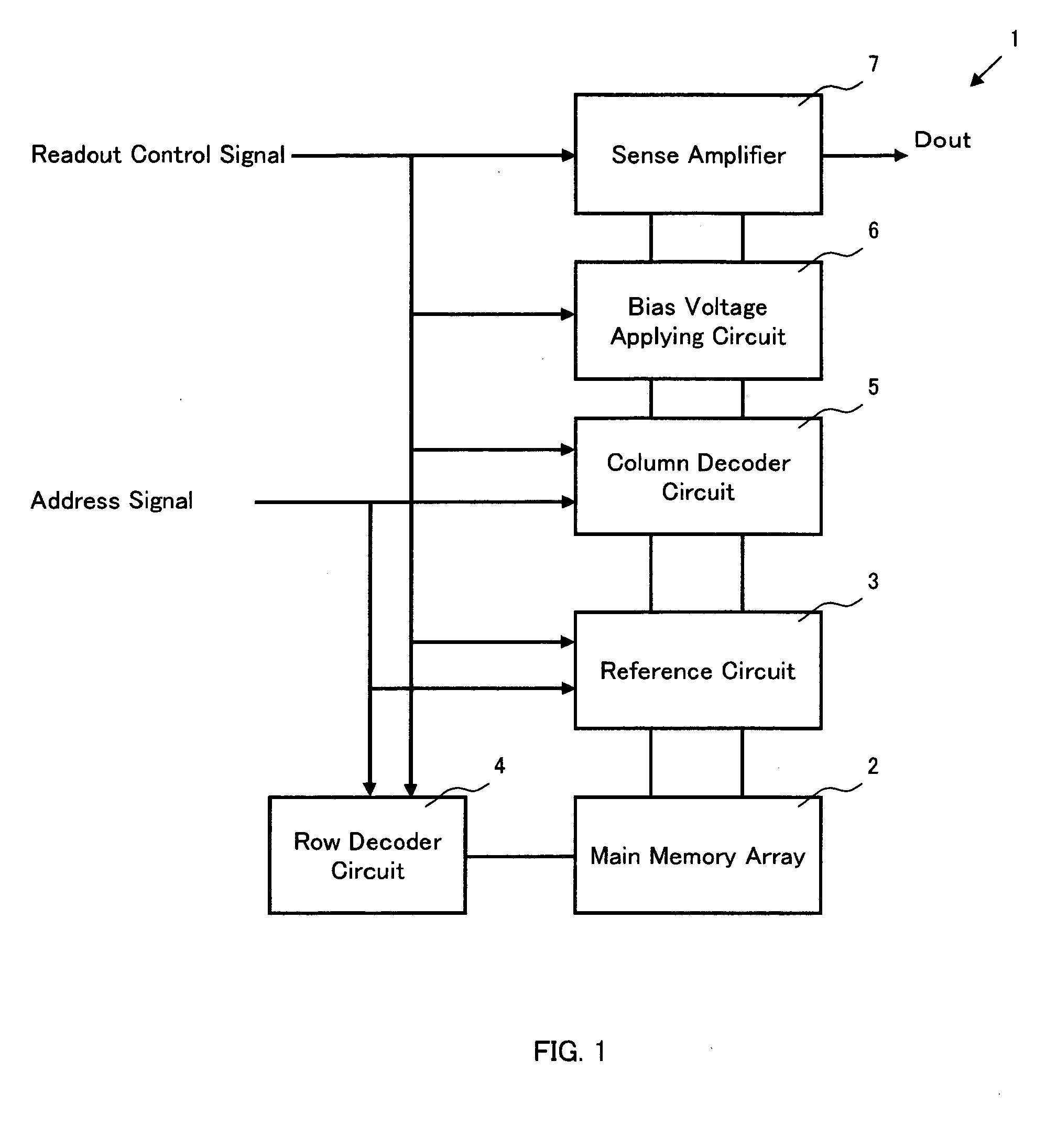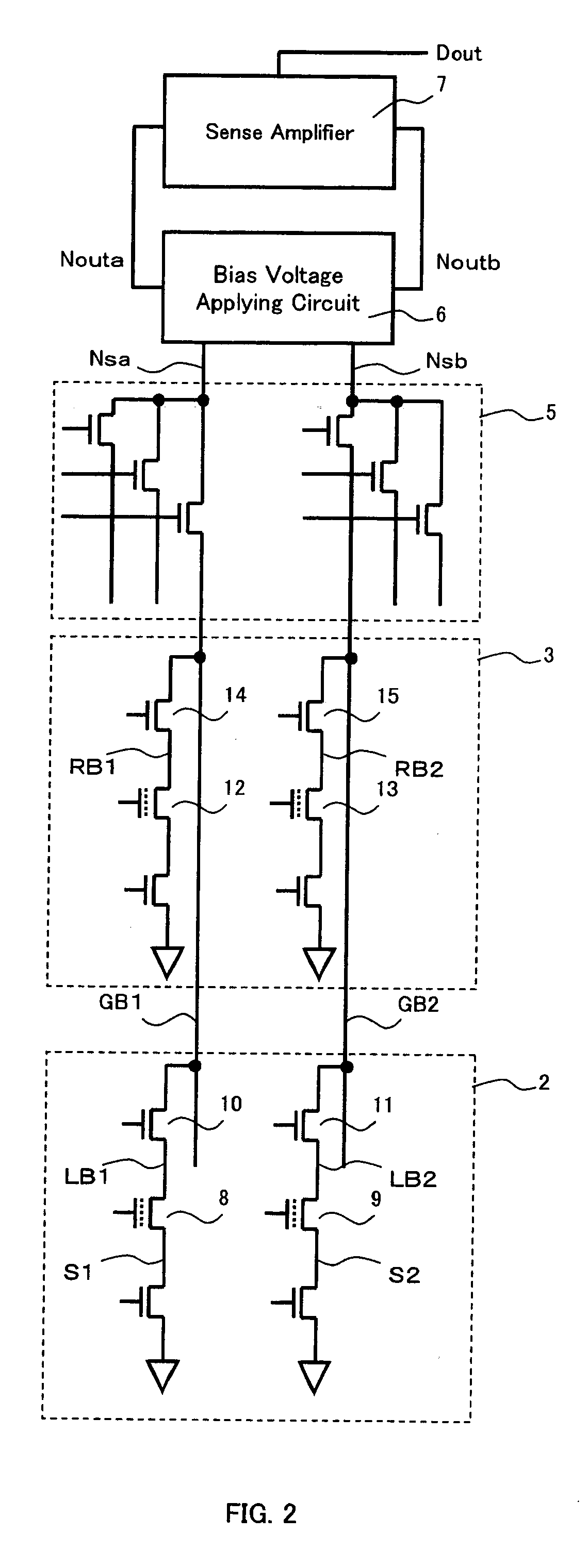Bias voltage applying circuit and semiconductor memory device
a bias voltage and semiconductor technology, applied in the field of semiconductor memory devices, can solve the problems of affecting high-speed readout, deteriorating transient characteristics, increasing the bit line, etc., and achieve the effect of high-speed readout operation
- Summary
- Abstract
- Description
- Claims
- Application Information
AI Technical Summary
Benefits of technology
Problems solved by technology
Method used
Image
Examples
first embodiment
[0051] A first embodiment of a semiconductor memory device and a bias voltage applying circuit according to the present invention (occasionally referred to as “inventive device” and “inventive circuit”, respectively, hereinafter) will be described with respect to the accompanying drawings.
[0052] As shown in FIG. 1, an inventive device 1 comprises a main memory array 2, a reference circuit 3, a row decoder 4, a column decoder 5, a bias voltage applying circuit 6 according to the present invention, a sense amplifier 7 and the like. In addition, necessary address signal and a readout control signal (a chip enable signal, an output enable signal and the like) are input to each part through an input circuit although they are not shown. In addition, an output Dout of the sense amplifier 7 is output to an external circuit through a predetermined output circuit.
[0053] The main memory array 2 is so constituted that a plurality of memory cells to be read out are arranged in the row directio...
second embodiment
[0072] Next, a circuit constitution and a circuit operation of a semiconductor memory device according to a second embodiment of the present invention will be described with reference to the drawings.
[0073] As shown in FIG. 11, an inventive circuit 6 of this embodiment comprises two bias circuits 30 which are entirely equivalent to each other. Similar to the first embodiment, one of them is referred to as a first bias circuit 30a and the other is referred to as a second bias circuit 30b for convenience. In addition, similar to the first embodiment, one of two current sources Ia and Ib designates a memory cell current Icell of the selected memory cell and the other designates a memory cell current Iref of the reference memory cell. The memory cell current Icell of the selected memory cell is changed depending on the threshold voltage corresponding to the storage information.
[0074] The bias circuit 30a (30b) of this embodiment comprises six active elements comprising MOSFETs. A firs...
third embodiment
[0084] Next, a circuit constitution and a circuit operation of a semiconductor memory device according to a third embodiment of the present invention will be described with reference to the drawings. Although the current path of the memory cell current Icell or the reference memory cell current Iref which was copied from the first active element to the third active element is divided in the second embodiment, a current path is not divided in this embodiment and a current is copied from a first active element to a third active element and a fourth active element.
[0085] As shown in FIG. 12, an inventive circuit 6 of this embodiment comprises two bias circuits 40 which are entirely equivalent to each other. Similar to the first and second embodiments, one of them is referred to as a first bias circuit 40a and the other is referred to as a second bias circuit 40b for convenience. In addition, similar to the first and second embodiments, one of two current sources Ia and Ib designates a...
PUM
 Login to View More
Login to View More Abstract
Description
Claims
Application Information
 Login to View More
Login to View More - R&D
- Intellectual Property
- Life Sciences
- Materials
- Tech Scout
- Unparalleled Data Quality
- Higher Quality Content
- 60% Fewer Hallucinations
Browse by: Latest US Patents, China's latest patents, Technical Efficacy Thesaurus, Application Domain, Technology Topic, Popular Technical Reports.
© 2025 PatSnap. All rights reserved.Legal|Privacy policy|Modern Slavery Act Transparency Statement|Sitemap|About US| Contact US: help@patsnap.com



